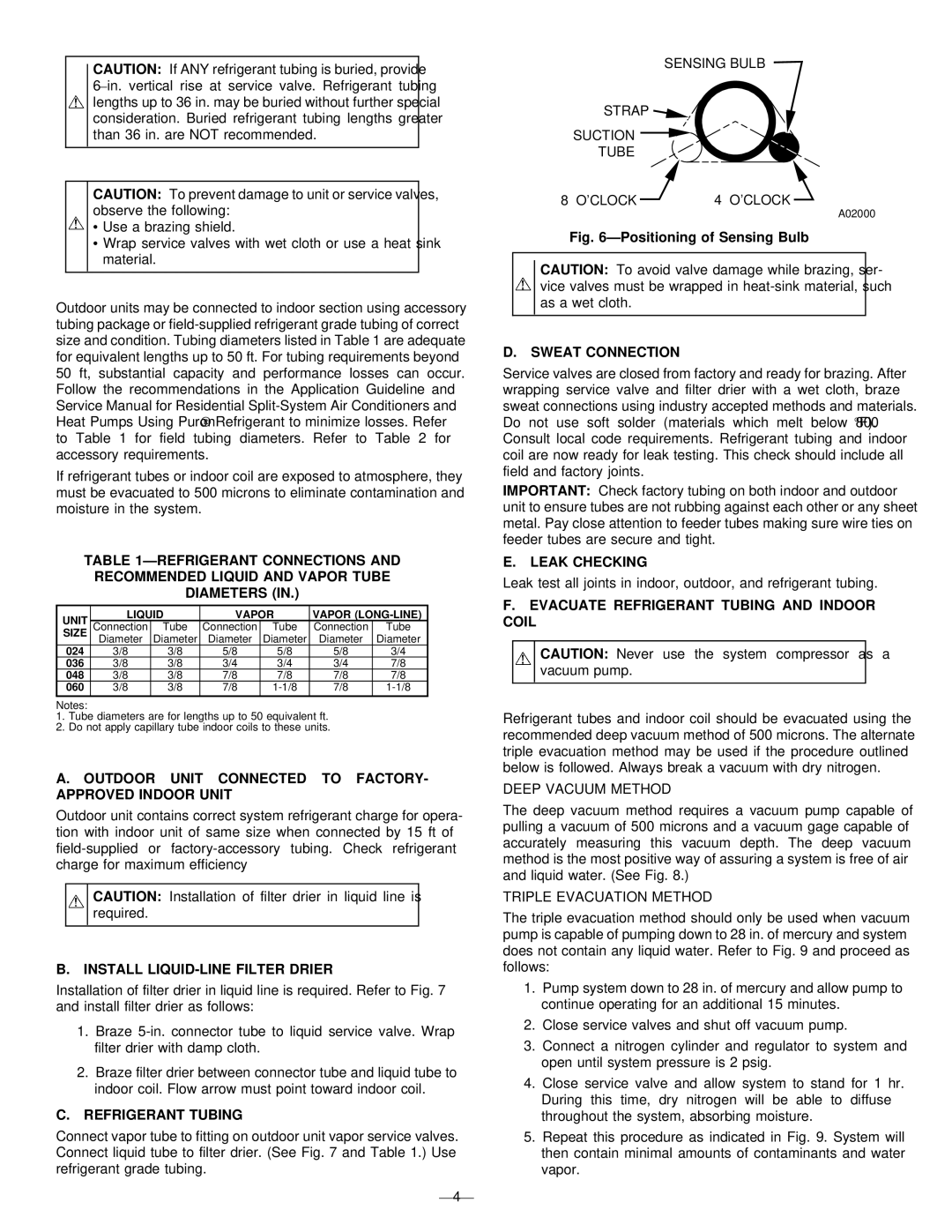CAUTION: If ANY refrigerant tubing is buried, provide 6–in. vertical rise at service valve. Refrigerant tubing lengths up to 36 in. may be buried without further special consideration. Buried refrigerant tubing lengths greater than 36 in. are NOT recommended.
CAUTION: To prevent damage to unit or service valves, observe the following:
• Use a brazing shield.
•Wrap service valves with wet cloth or use a heat sink material.
Outdoor units may be connected to indoor section using accessory tubing package or field-supplied refrigerant grade tubing of correct size and condition. Tubing diameters listed in Table 1 are adequate for equivalent lengths up to 50 ft. For tubing requirements beyond 50 ft, substantial capacity and performance losses can occur. Follow the recommendations in the Application Guideline and Service Manual for Residential Split-System Air Conditioners and Heat Pumps Using Puron® Refrigerant to minimize losses. Refer to Table 1 for field tubing diameters. Refer to Table 2 for accessory requirements.
If refrigerant tubes or indoor coil are exposed to atmosphere, they must be evacuated to 500 microns to eliminate contamination and moisture in the system.
TABLE 1—REFRIGERANT CONNECTIONS AND RECOMMENDED LIQUID AND VAPOR TUBE DIAMETERS (IN.)
| UNIT | LIQUID | VAPOR | VAPOR (LONG-LINE) |
| Connection | Tube | Connection | Tube | Connection | Tube |
| SIZE |
| | Diameter | Diameter | Diameter | Diameter | Diameter | Diameter |
| 024 | 3/8 | 3/8 | 5/8 | 5/8 | 5/8 | 3/4 |
| 036 | 3/8 | 3/8 | 3/4 | 3/4 | 3/4 | 7/8 |
| 048 | 3/8 | 3/8 | 7/8 | 7/8 | 7/8 | 7/8 |
| 060 | 3/8 | 3/8 | 7/8 | 1-1/8 | 7/8 | 1-1/8 |
Notes:
1.Tube diameters are for lengths up to 50 equivalent ft.
2.Do not apply capillary tube indoor coils to these units.
A. OUTDOOR UNIT CONNECTED TO FACTORY- APPROVED INDOOR UNIT
Outdoor unit contains correct system refrigerant charge for opera- tion with indoor unit of same size when connected by 15 ft of field-supplied or factory-accessory tubing. Check refrigerant charge for maximum efficiency
CAUTION: Installation of filter drier in liquid line is required.
B. INSTALL LIQUID-LINE FILTER DRIER
Installation of filter drier in liquid line is required. Refer to Fig. 7 and install filter drier as follows:
1.Braze 5-in. connector tube to liquid service valve. Wrap filter drier with damp cloth.
2.Braze filter drier between connector tube and liquid tube to indoor coil. Flow arrow must point toward indoor coil.
C.REFRIGERANT TUBING
Connect vapor tube to fitting on outdoor unit vapor service valves. Connect liquid tube to filter drier. (See Fig. 7 and Table 1.) Use refrigerant grade tubing.
—4—
SENSING BULB
STRAP
SUCTION 
TUBE
A02000
Fig. 6—Positioning of Sensing Bulb
CAUTION: To avoid valve damage while brazing, ser- vice valves must be wrapped in heat-sink material, such as a wet cloth.
D. SWEAT CONNECTION
Service valves are closed from factory and ready for brazing. After wrapping service valve and filter drier with a wet cloth, braze sweat connections using industry accepted methods and materials. Do not use soft solder (materials which melt below 800°F). Consult local code requirements. Refrigerant tubing and indoor coil are now ready for leak testing. This check should include all field and factory joints.
IMPORTANT: Check factory tubing on both indoor and outdoor unit to ensure tubes are not rubbing against each other or any sheet metal. Pay close attention to feeder tubes making sure wire ties on feeder tubes are secure and tight.
E. LEAK CHECKING
Leak test all joints in indoor, outdoor, and refrigerant tubing.
F.EVACUATE REFRIGERANT TUBING AND INDOOR COIL
CAUTION: Never use the system compressor as a vacuum pump.
Refrigerant tubes and indoor coil should be evacuated using the recommended deep vacuum method of 500 microns. The alternate triple evacuation method may be used if the procedure outlined below is followed. Always break a vacuum with dry nitrogen.
DEEP VACUUM METHOD
The deep vacuum method requires a vacuum pump capable of pulling a vacuum of 500 microns and a vacuum gage capable of accurately measuring this vacuum depth. The deep vacuum method is the most positive way of assuring a system is free of air and liquid water. (See Fig. 8.)
TRIPLE EVACUATION METHOD
The triple evacuation method should only be used when vacuum pump is capable of pumping down to 28 in. of mercury and system does not contain any liquid water. Refer to Fig. 9 and proceed as follows:
1.Pump system down to 28 in. of mercury and allow pump to continue operating for an additional 15 minutes.
2.Close service valves and shut off vacuum pump.
3.Connect a nitrogen cylinder and regulator to system and open until system pressure is 2 psig.
4.Close service valve and allow system to stand for 1 hr. During this time, dry nitrogen will be able to diffuse throughout the system, absorbing moisture.
5.Repeat this procedure as indicated in Fig. 9. System will then contain minimal amounts of contaminants and water vapor.

